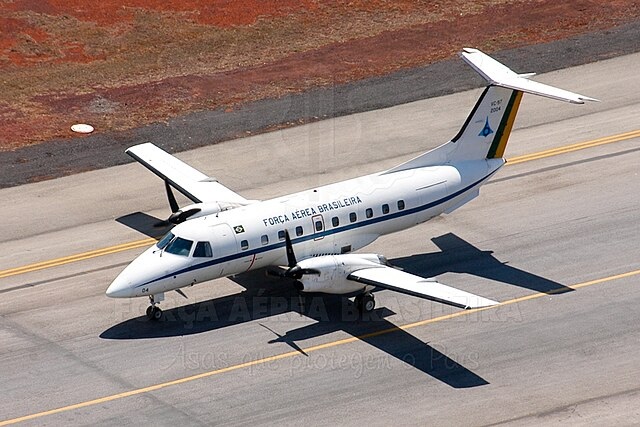EMB 120 Brasilia
Summary
| Category | Military Transport Aircrafts |
| Origin country | 🇧🇷 Brazil |
| Manufacturer | Embraer |
| First flight | 27 July 1979 |
| Year introduced | 1985 |
| Number produced | 357 units |
| Average unit price | $5 million |
Description
Following the success of the EMB 110 Bandeirante, Embraer commenced work on developing their first transport category airliner in 1974. This effort culminated in the Family 12X, which comprised three models with a modular design concept: the EMB 120 Araguaia, EMB 123 Tapajós, and EMB 121 Xingu. The original EMB 120 was conceived as a straightforward stretch of the EMB 121, facilitating a high degree of commonality between the two types. However, only the EMB 121 would be produced in its original form, as the EMB 120 was redesigned in 1979, discarding the Araguaia name. The revised concept, named Brasilia at its official project launch in 1979, was heavily influenced by suggestions from prospective operators attending the Commuter Airline Association of America convention. The renaming reflected the extent of the changes; being a completely new aircraft, it had no parts in common with the EMB 121 Xingu. Furthermore, the capacity was revised downwards from 30 to 24 seats and it was redesigned to make use of more powerful PW118 engines, which produced up to 1,892 shp. On 27 July 1983, the PW115-powered EMB 120 prototype performed its maiden flight. During October 1985, the first aircraft entered service with Atlantic Southeast Airlines. Production of the EMB 120 was terminated during 2001.
In terms of its basic configuration, the EMB 120 features a circular cross-section fuselage, low-mounted straight wings and a T-tail. The fuselage is of semi-monocoque design, its skin being composed of an aluminium alloy. The wing structure comprises a single three-spar design that is linked to the frames of the lower side of the fuselage. The nose cone, dorsal fin and leading edges of the wing and tailplane primarily comprise a Kevlar-reinforced glass fibre. The aircraft is equipped with retractable tricycle landing gear, which is actuated hydraulically and fitted with Goodrich-supplied wheels, oleo-pneumatic shock absorbers, a Hydro Aire anti-skid system, and either carbon or steel brakes. Depending on configuration, the cockpit featured either a Collins analog Flight Instrument System, a Collins five-screen Electronic Flight Instrument System, or a Bendix five-screen Electronic Flight Instrument System, alongside dual autopilots.
The majority of EMB 120s were sold in the United States and other countries across the Western Hemisphere. US airlines operating the type have included Great Lakes Airlines, which had six EMB 120s in its fleet, while Ameriflight was flying ten freighter-configured EMB 120s as late as 2022. The largest operator of the type in the United States was SkyWest Airlines, which operated more than 62 at one point, before retiring the fleet in early 2015. Several European airlines, such as Régional in France, Atlant-Soyuz Airlines in Russia, DAT in Belgium, and DLT in Germany, also purchased EMB 120s. The EMB 120 has also proven itself to be popular amongst African operators, with Sahara African Aviation operating as many as nine EMB 120ERs. Several military operators also procured the type, such as the Angolan Air Force, which received new-build aircraft during 2007, while the Brazilian Air Force operated a specialised VIP transport version, the VC-97.
Main variants:
-
EMB 120: The basic production version, serving as the foundation for subsequent variants.
-
EMB 120ER: An extended-range and increased-capacity version, which could be converted into the EMB 120FC or EMB 120QC models.
-
EMB 120FC: A full cargo version, designed to maximize cargo-carrying capabilities.
-
EMB 120QC: A quick-change cargo version, allowing for rapid reconfiguration between passenger and cargo transport.
-
EMB 120RT: A transport version that could be upgraded to the EMB-120ER standard.
Technical specifications
| Version: EMB-120 | |
|---|---|
| Maximum speed | 608 km/h (378 mph) |
| Wing area | 39.4 m² (424.1 sqft) |
| Wingspan | 19.8 m (64.9 ft) |
| Height | 6.4 m (20.8 ft) |
| Length | 20 m (65.6 ft) |
| Service ceiling | 9,083 m (29,800 ft) |
| Empty weight | 7,070 kg (15,587 lbs) |
| Max. takeoff weight | 11,500 kg (25,353 lbs) |
| Takeoff distance | 1,420 m (4,659 ft) |
| Powerplant | 2 x turboprops Pratt & Whitney Canada PW118 delivering 1342 kW each |


